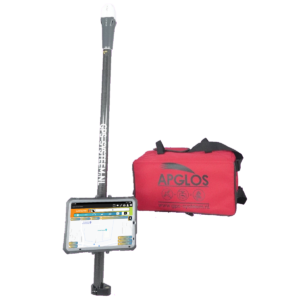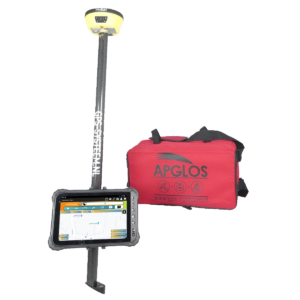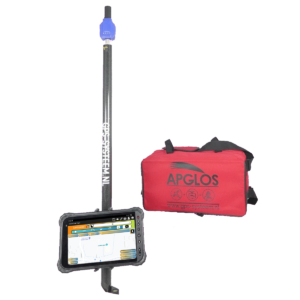Altus NR3, alles over deze geweldige GPS ontvanger

De Altus NR3 van Septentrio is één van de velen GPS ontvangers op de markt. Misschien is deze GPS ontvanger minder bekend dan de ontvangers van bekende merken als Topcon, Leica en Trimble. Maar de Altus NR3 is wel één van de meest hoogwaardige GPS ontvangers in de markt.
De Altus NR3 van Septentrio is een GPS ontvanger, die ideaal is om mee te landmeten. Ook voor GIS toepassingen en metingen op het water is deze GPS ontvanger een goede oplossing. Deze ontvanger heeft diverse grote voordelen. Eén daarvan is AIM+. AIM+ zorgt ervoor dat de ontvanger goed bestand is tegen jamming van satellietsignalen, waardoor de Altus NR3 nog steeds nauwkeurig een positie kan bepalen, wanneer de satellietsignalen worden gejamd. Daarnaast heeft deze GPS ontvanger APME+. Hierdoor kan de ontvanger nog steeds een nauwkeurige positie bepalen wanneer satellietsignalen worden weerkaatst door gladde oppervlakken. De Altus NR3 staat voor nauwkeurigheid. En dat is wat u wilt wanneer u met GPS landmeet.
Om alles duidelijk te maken over dit onderwerp zullen we in dit artikel de volgende vragen beantwoorden:
- Wat is een Altus NR3?
- Wat zijn de voordelen van de Altus NR3?
- Welke varianten van de Altus NR3 zijn er?
- Wat zijn de specificaties van de Altus NR3?
- Waar kan u een Altus NR3 kopen?
- Waar kan u de handleiding vinden van de Altus NR3?
- Wat is de beste software om met de Altus NR3 te landmeten?
Altus NR3: de oplossing
Het kan zo zijn dat u niet in de gelegenheid bent om dit gehele artikel te lezen. Daarom is er nog een mogelijkheid om meer te weten te komen over Altus NR3.
U kunt via deze website een GPS meetsysteem proberen. Kijk daarvoor direct op deze pagina. Zet dan wel in de opmerkingen bij de bestelling dat u een Altus NR3 wilt proberen.
U kunt op dezelfde pagina een demonstratie aanvragen van één van onze GPS meetsystemen. Bij deze demonstratie kunt u dan ook gerichte vragen stellen over Altus NR3 en natuurlijk ook over andere onderwerpen met betrekking tot GPS landmeten.
Mocht u geen tijd hebben voor een demonstratie of wilt u alleen de beste software voor deze GPS ontvanger proberen dan is dat mogelijk. Apglos Survey Wizard is de eenvoudigste software om GPS metingen met deze GPS ontvanger of welke andere GPS ontvanger dan ook, mee uit te voeren. U kunt deze gratis downloaden van de Google Play Store.
De landmeetapp Apglos Survey Wizard heeft volledige functionaliteit met de GPS van uw Android apparaat. U kunt deze app dus volledig testen en het is gratis.
Natuurlijk is de nauwkeurigheid van onze GPS ontvangers, en met name de Altus NR3, beter dan die van de standaard Android apparaten. Mocht u dus een test willen doen met een nauwkeurig systeem, kijk dan op deze pagina.
Wat is een Altus NR3?
De Altus NR3 is een GPS ontvanger. Hij vangt met de geïntegreerde antenne satellietsignalen op. Dit kunnen zijn satellietsignalen van de satelliet constellaties GPS, GLONASS, GALILEO en BEIDOU. En aan de hand van de satellietsignalen bepaald deze GPS ontvanger de exacte positie.

Deze GPS ontvanger is van Belgische makelij. Het Belgische bedrijf Septentrio heeft deze GPS ontvanger ontwikkelt en bouwt deze nog steeds. Aangezien het een Belgische bedrijf is, is het extra leuk dat ze er een Nederlands tintje aan hebben gegeven: oranje.
Wat zijn de voordelen van de Altus NR3?
Zoals u misschien weet zijn er veel verschillende GPS ontvangers. En u vraagt zich waarschijnlijk af waarom de Altus NR3 dan zo speciaal is. Dat is in ieder geval een hele goede vraag.
Er zijn namelijk inderdaad heel veel GPS ontvangers. Maar deze GPS ontvanger heeft een aantal heel interessante kenmerken. Deze GPS ontvanger is ontwikkeld door intelligente mensen, die snappen wat ze doen. En dat blijkt ook uit de onderstaande kenmerken. Deze kenmerken geven de Altus NR3 een groot voordeel ten opzichte van andere GPS ontvangers.
Natuurlijk is het een voordeel dat deze GPS ontvanger licht in gewicht is, maar er zijn ook technische kenmerken / voordelen.
Weerstand tegen jamming: AIM+
De positie wordt door elke GPS ontvanger bepaald aan de hand van satellietsignalen. De satellietsignalen vliegen vanaf de satelliet door de atmosfeer en de lucht naar de GPS ontvanger. In de tijd dat het signaal onderweg is van de satelliet naar de GPS ontvanger kunnen er verschillende dingen met het signaal gebeuren.
Eén daarvan is jamming. Bij jamming worden de satellietsignalen opzettelijk of per ongeluk geblokkeerd. Veel GPS ontvangers raken daardoor tijdelijk van slag en kunnen dan niet de exacte positie bepalen.
Bij de Altus NR3 zit er echter een systeem in de GPS ontvanger, waardoor hij de inmenging van deze blokkades kan onderdrukken. Hierdoor kan deze GPS ontvanger vaak nog steeds een exacte positie bepalen, wanneer er opzettelijk of onbedoeld jamming van GPS signalen plaats vindt.
Trillingsweerstand: LOCK+
Wanneer u aan het landmeten bent, dan kan het wel eens zijn dat de GPS ontvanger door elkaar wordt geschud. Dit gebeurt voornamelijk bij ruw terrein, waar u takken, bomen of andere zaken moet ontwijken.
De schokken of trillingen kunnen ertoe lijden dat het volgen van de satellietsignalen door de GPS ontvanger lastig is. Het is voor een GPS ontvanger makkelijker om de positie exact te blijven bepalen, wanneer deze continu signalen van dezelfde satellieten ontvangt.
De ontwikkelaars van Septentrio hebben daarom LOCK+ in de Altus NR3 gebouwd. Met behulp van LOCK+ is het volgen van satellieten makkelijker. Hierdoor verliest deze GPS ontvanger minder snel de exacte positie dan andere GPS ontvangers. En daardoor kan er sneller worden gewerkt met deze GPS ontvanger.
Dat is natuurlijk wat u wilt, wanneer u aan het landmeten bent.
Weerstand tegen invloeden uit de atmosfeer: IONO+
De satellietsignalen gaan van de satelliet naar de GPS ontvanger door de atmosfeer. De atmosfeer is niet altijd gelijk. Dat is één van de belangrijkste redenen dat het lastig is om exact de positie te bepalen met GPS.
De ontwikkelaars van Septentrio hebben gekeken naar de atmosferische invloed op de GPS signalen. Op basis van die studie hebben zijn IONO+ ontwikkeld. IONO+ is de meest geavanceerde bescherming tegen storingen in de atmosfeer.
Dat is zeker van belang voor een GPS ontvanger waar de atmosferische invloeden groot zijn. Maar ook in Nederland is het een voordeel.
Hoe beter de bescherming is tegen atmosferische invloeden, hoe nauwkeuriger u met GPS kunt meten. En uiteindelijk wanneer u meet dan wilt u wel dat het nauwkeurig is.
Weerstand tegen weerkaatsing satellietsignalen: APME+
En naast de atmosfeer en mogelijk geblokkeerde satellietsignalen is er nog iets waar de Altus NR3 rekening mee houdt. De satellietsignalen kunnen kaatsten tegen metalen objecten of spiegelwanden.
Het zou op deze manier kunnen dat er door deze kaatsing twee signalen van één satelliet bij de GPS ontvanger binnen komen. Eén daarvan is het echte signaal en het andere is een weerkaatsing ervan.
De gegevens van beide signalen zijn vaak niet gelijk aan elkaar. Door de weerkaatsing is de weg van de satelliet naar de GPS ontvanger vaak langer dan het directe signaal. En hierdoor is deze ook langer onderweg. De GPS ontvanger krijgt zo hetzelfde bericht binnen van dezelfde satelliet maar op een ander tijdstip.
Het kan ook zijn dan de GPS ontvanger alleen het weerkaatste satellietsignaal ontvangt. Dit satellietsignaal is onjuist.
U kunt waarschijnlijk begrijpen dat het hierdoor voor GPS ontvangers lastig is om de exacte positie te bepalen bij grote metalen objecten of spiegelwanden.
Echter in de Altus NR3 zit APME+ ingebouwd. APME+ zorgt ervoor dat de directe en weerkaatste satellietsignalen van elkaar gescheiden worden. Hierdoor gebruikt deze GPS ontvanger alleen de directe signalen en kan een betere en nauwkeurigere positiebepaling worden gegarandeerd.
Integriteitsmechanisme: RAIM+
Naast al de bovenstaande technieken bezit de Altus NR3 nog een techniek. Dit is RAIM+. RAIM+ zorgt controleert alle mechanismen van de GPS ontvanger om van de satellietsignalen een exacte positie te bepalen.
Wanneer er bij deze controle fouten worden geconstateerd, dan worden deze gecorrigeerd door het RAIM+.
Septentrio wil met de RAIM+ ervoor zorgen dat de positie door deze GPS ontvanger zo nauwkeurig mogelijk wordt bepaald. En dat is een goed streven.
Bij landmeten draait het namelijk om nauwkeurige positiebepaling.
Welke varianten van de Altus NR3 zijn er?
Deze GPS ontvanger heeft dus veel voordelen. Maar zoals zoveel producenten biedt Septentrio ook een aantal varianten van de Altus NR3 aan. Deze GPS ontvanger heeft meerdere varianten. Gelukkig is het onderscheid tussen de verschillende varianten van deze GPS ontvanger niet moeilijk.
Het onderscheid heeft namelijk uitsluitend te maken met de satellietconstellaties die de GPS ontvanger ontvangt en daarna gebruikt om de exacte positie te bepalen.
Op dit moment zijn er vier grote satellietconstellaties. De oudste en meest bekende is GPS. Dit zijn de Amerikaanse satellieten. Na GPS kwam GLONASS. Dit zijn de satellieten van Rusland. En daarna kwamen er nog twee. Dit zijn GALILEO van Europa en BEIDOU van China.
Er zijn van de Altus NR3 vier varianten. De eerste is de basisvariant. En deze kan alleen GPS en GLONASS ontvangen.
Voor de andere drie varianten geldt dat de te ontvangen satellietconstellaties kan worden uitgebreid. Zo is er de variant die de satellietsignalen ontvangt van GPS, GLONASS en GALILEO. Natuurlijk is er dan ook de variant die GPS, GLONASS en BEIDOU satellietsignalen kan ontvangen. En dan als laatste is er nog een variant die de satellietsignalen van al deze vier satellietconstellaties kan ontvangen.
Uiteindelijk werkt de basisvariant goed. Maar des te meer satellietconstellaties de GPS ontvanger kan ontvanger des te vaker kan de GPS ontvanger een nauwkeurige positie bepalen.
Wat zijn de specificaties van de Altus NR3?
GPS ontvangers hebben veel specificaties. Zo heeft de Altus NR3 dat ook.
Een belangrijke specificatie gaat over welke satellieten de GPS ontvanger kan ontvangen. Hiervoor heb ik al aangegeven over de verschillende satellietconstellaties GPS, GLONASS, GALILEO en BEIDOU.
Maar elke satellietconstellatie heeft ook nog haar eigen groepen. Zo heeft GPS de groepen L1, L2 en L5. De Altus NR3 kan de satellietsignalen van al deze groepen ontvangen. Dit geldt ook voor de groepen L1, L2 en L3 van GLONASS.
Van de varianten die GALILEO kunnen ontvangen geldt dat ze de groepen E1, E5a, E5b en AltBoc kunnen ontvangen.
En voor de varianten die BEIDOU ontvangen geldt dat ze de groepen B1 en B2 kunnen ontvangen.
Zoals bekend geldt natuurlijk dat als een GPS ontvanger meer groepen van satellietsignalen kan ontvangen het makkelijker wordt om overal te kunnen landmeten.
Uiteindelijk is het type satellietsignalen dat de Altus NR3 kan ontvangen, maar één specificatie. Er zijn natuurlijk nog veel meer specificaties voor deze GPS ontvanger. Al deze specificaties zijn door Septentrio verzameld in een overzichtelijk specificatieblad.
Dat specificatieblad kunt u hier downloaden.
Waar kan u een Altus NR3 kopen?
Dit is eigenlijk een heel makkelijke vragen. Apglos BV, waar GPS-systeem.nl onderdeel van is, is officieel dealer van Septentrio. Dit betekent natuurlijk dat u de Altus NR3 GPS ontvanger bij ons kunt kopen.
Mocht u interesse hebben in deze ontvanger dan kunt u contact met ons opnemen.
[contact-form-7 id=”913″ title=”Contact”]
Misschien vindt u het raar dat er geen GPS meetsysteem met een Altus NR3 op deze website staat. Dat heeft een aantal redenen.
Ten eerste is de prijs van de Altus NR3 hoger dan van de GPS ontvanger, die we op onze koop- en probeerpagina hebben staan. De prijs ligt tussen de € 7000,- en € 9000,- voor alleen de GPS ontvanger.
De verklaring dat er tussen de Emlid Reach RS2 en de Altus NR3 een groot prijsverschil zit is vrij eenvoudig. Beide doen in principe hetzelfde. Maar er zijn natuurlijk wel verschillen. Septentrio heeft deze GPS ontvanger technisch enorm uitgewerkt. Dat kunt u ook lezen bij de voordelen van de Altus NR3 die ik genoemd heb.
Daarnaast zijn er van deze GPS ontvanger verschillende varianten. Voor de Emlid Reach RS2 geldt dat er maar één variant is.
Beide redenen zorgen ervoor dat wanneer u geïnteresseerd bent in we graag u persoonlijk advies geven. We willen er namelijk voor zorgen dat wanneer u voor een hoogwaardige GPS ontvanger kiest u wel de juiste kiest, waar u ook iets mee kunt. En dus kunt meten hoe u wilt.
Daarom is het verstandig om als u interesse heeft in een Altus NR3 van Septentrio om contact met ons op te nemen.
Waar kan u de handleiding vinden van de Altus NR3?
De Altus NR3 is makkelijk te bedienen. Hij heeft maar één knop en dat is de aan- en uitknop. Daarnaast heeft de voorzijde van deze GPS ontvanger een achttal LEDs. Met iconen is aangegeven waar deze voor staan.

Van de Altus NR3 is natuurlijk een handleiding. Er is zelfs een snelstartblad. Maar voordat ik u wil wijzen op de links naar de handleiding en het snelstartblad wil ik nog een heel belangrijk ding zeggen over deze GPS ontvanger.
Dit gaat over het uitzetten. Het is heel belangrijk om bij het uitzetten de aan- en uitknop niet te lang ingedrukt te houden. Wanneer de LEDs gaan branden is het noodzakelijk om uw vinger van deze knop te halen.
Mocht u dat niet doen dan zal de Altus NR3 zich resetten. En dan zal de GPS ontvanger de eerste keer wanneer u de ontvanger aanzet de fabrieksinstellingen gebruiken. Dit zijn vaak niet de instellingen die u nodig heeft om te landmeten.
Maar dat wetende dan nu de links:
Wat is de beste software om met de Altus NR3 te landmeten?
Met alleen een GPS ontvanger kunt u niet zoveel. Dat geldt ook voor de Altus NR3. Om te landmeten heeft u ook landmeetkundige software nodig. Maar er zijn verschillende landmeetkundige softwarepakketten.
Voor iedereen adviseer ik om Apglos Survey Wizard te gebruiken. Dit is een eenvoudige landmeetapp die door iedereen is te gebruiken, zonder dat er veel voor gestudeerd moet worden. Apglos Survey Wizard is namelijk intuïtief.
En deze landmeetapp werkt geweldig met de Altus NR3. Veel mensen gebruiken deze combinatie zonder problemen. U kunt deze app ook zelf downloaden in de Google Play Store.
Met betrekking tot deze combinatie is er nog een leuk weetje. De voorganger van de Altus NR3 is de Altus NR2. En de Altus NR2 is de eerste GPS ontvanger waar Apglos Survey Wizard, of diens voorganger Apglos HST, verbinding mee heeft gemaakt.
Apglos Survey Wizard en de Altus NR3 hebben daardoor een goede relatie met elkaar.
Slotconclusie over Altus NR3
Dit was een heel artikel over Altus NR3. Er is veel over dit onderwerp van GPS landmeten te melden. We hopen dan ook dat u er in ieder geval een aantal zaken van heeft opgepikt en dat u daar u voordeel mee kunt doen.
Echter is alles wat in dit artikel is geschreven theorie. Als u deze theorie in de praktijk wilt brengen dan kan dat.
U kunt namelijk via deze website een GPS meetsysteem met een Altus NR3 proberen. Meldt dan wel bij de bestelling dat u een Altus NR3 van Septentrio wilt proberen. Wanneer u dat doet dan kunt u wat u door het lezen van dit artikel direct in de praktijk brengen. En u kunt zien of het werken met deze GPS ontvanger van Septentrio iets voor u is.
Natuurlijk krijgt u wanneer u één van onze GPS meetsystemen probeert of koopt nog een korte en duidelijke uitleg, zodat u direct ermee aan de slag kunt.
Mocht u eerst een demonstratie willen dan kunt u die ook via de hierboven genoemde pagina’s aanvragen. Bij een demonstratie of een korte uitleg kunt u ook nog specifieke vragen stellen over Altus NR3.



